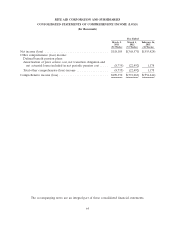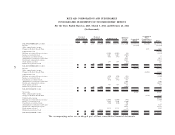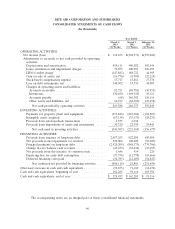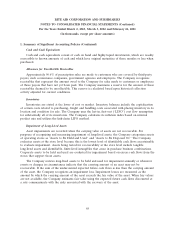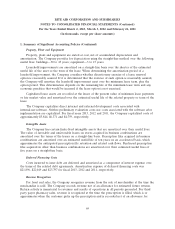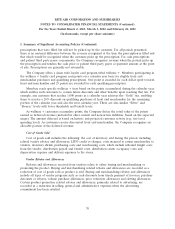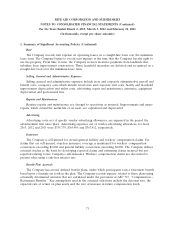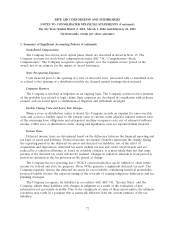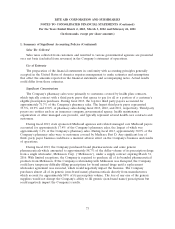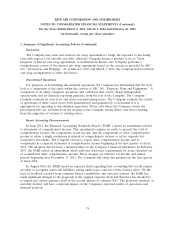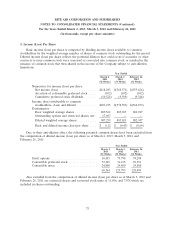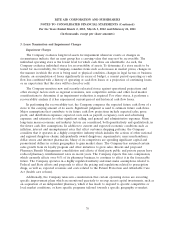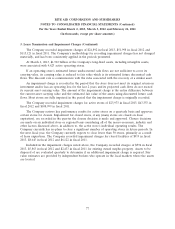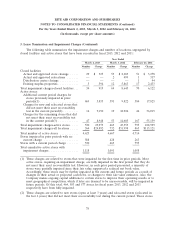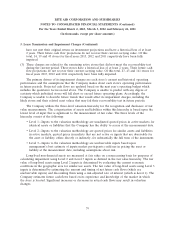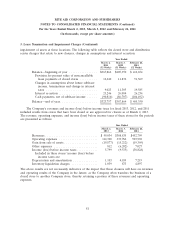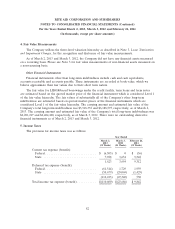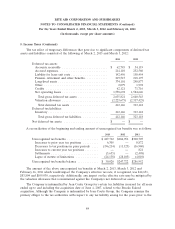Rite Aid 2013 Annual Report Download - page 75
Download and view the complete annual report
Please find page 75 of the 2013 Rite Aid annual report below. You can navigate through the pages in the report by either clicking on the pages listed below, or by using the keyword search tool below to find specific information within the annual report.RITE AID CORPORATION AND SUBSIDIARIES
NOTES TO CONSOLIDATED FINANCIAL STATEMENTS (Continued)
For the Years Ended March 2, 2013, March 3, 2012 and February 26, 2011
(In thousands, except per share amounts)
1. Summary of Significant Accounting Policies (Continued)
Derivatives
The Company may enter into interest rate swap agreements to hedge the exposure to increasing
rates with respect to its variable rate debt, when the Company deems it prudent to do so. Upon
inception of interest rate swap agreements, or modifications thereto, the Company performs a
comprehensive review of the interest rate swap agreements based on the criteria as provided by ASC
815, ‘‘Derivatives and Hedging.’’ As of March 2, 2013 and March 3, 2012, the Company had no interest
rate swap arrangements or other derivatives.
Discontinued Operations
For purposes of determining discontinued operations, the Company has determined that the store
level is a component of the entity within the context of ASC 360, ‘‘Property, Plant and Equipment.’’ A
component of an entity comprises operations and cash flows that can be clearly distinguished,
operationally and for financial reporting purposes, from the rest of the Company. The Company
routinely evaluates its store base and closes non-performing stores. The Company evaluates the results
of operations of these closed stores both quantitatively and qualitatively to determine if it is
appropriate for reporting as discontinued operations. Stores sold where the Company retains the
prescription files are excluded from the analysis as the Company retains direct cash flows resulting
from the migration of revenue to existing stores.
Recent Accounting Pronouncements
In June 2011, the Financial Accounting Standards Board (‘‘FASB’’) issued an amendment related
to statements of comprehensive income. This amendment requires an entity to present the total of
comprehensive income, the components of net income, and the components of other comprehensive
income in either a single continuous statement of comprehensive income or in two separate but
consecutive statements. The Company elected to report other comprehensive income and its
components in a separate statement of comprehensive income beginning in the first quarter of fiscal
2013. The adoption did not have a material effect on the Company’s financial statements. In February
2013, the FASB issued an amendment which adds new disclosure requirements for items classified out
of accumulated other comprehensive income. These changes are effective for interim and annual
periods beginning after December 15, 2012. The Company will adopt this guidance in the first quarter
of fiscal 2014.
In August 2010, the FASB issued an exposure draft regarding lease accounting that would require
an entity to recognize assets and liabilities arising under lease contracts on the balance sheet. On the
basis of feedback received from comment letters, roundtables, and outreach sessions, the FASB has
made significant changes to the proposals in the original exposure draft and therefore has decided to
re-expose the revised exposure draft in the second quarter of calendar 2013. The proposed standard, as
currently drafted, will have a material impact on the Company’s reported results of operations and
financial position.
74


